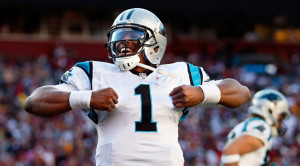Tom Brady lost four of his top five targets from 2012 and the fifth was Rob Gronkowski; in retrospect, most people underestimated how big of an impact this would have on Brady’s numbers. Meanwhile, Ben Roethlisberger’s receivers were a big question mark entering the season, but a monster year from Antonio Brown prevented Roethlisberger’s numbers from tanking. As it turned out, Roethlisberger didn’t wind up having much turnover, but the quarterback who experienced the second-most turnover wound up winning the Comeback Player of the Year award.
For Carolina, I think some of the departures have been overblown. The defense should again be one of the best in the NFL, and it’s not as though the passing game was outstanding last year. Greg Olsen led the team in receptions, receiving yards, and receiving touchdowns last year, and he’ll be back in 2014. In addition, the Panthers averaged 7.4 yards per attempt on passes to Greg Olsen last year and 7.1 yards per attempt (the league average) on passes to all other players. Carolina signed Jerricho Cotchery, Jason Avant, Tiquan Underwood, and Joe Webb, should draft a receiver or two in May, and has a potential sleeper in Marvin McNutt. I think they’ll be just fine, mostly because that’s all the passing game was last year.
Since it’s still a bit early to figure out exactly how the Panthers passing game will look in 2014, I thought we could use some time this weekend to review some history. Which teams have experienced the most turnover among their targets? And how do we even measure such a thing?
This is a bit trickier than you might think. For example, it’s not hard to come up with a formula that recognizes that the Ravens experienced a loss when Anquan Boldin was traded to San Francisco. And turnover isn’t just bad: the 49ers had just as much turnover in the Boldin trade, too.
Other parts of turnover are a bit trickier to measure. For example, Randall Cobb recorded 22.0% of the Packers receiving yards in 2012 and then just 9.5% last year. Similarly, Sidney Rice had 23.1% of Seattle’s receiving yards two years ago and then only 6.6% in 2013.
And what do you do with say, Julian Edelman? He was on the Patriots in 2012, but he was responsible for only 4.9% of New England’s receiving yards that season. Last year, he caught 24.3% of all Patriots yards, so he was a much more significant part of the passing game. Similarly, Alshon Jeffery jumped from 11.1% to 31.9% of the Bears’ receiving game from 2012 to 2013. That seems like it deserves nearly as much credit as say, Mike Wallace (23.4%) or Keenan Allen (23.3%) joining Miami or San Diego, respectively. So here’s the solution I came up with:
1) Calculate the percentage of team receiving yards [1]Note: I eliminated all players who finished the season with negative receiving yards. As a result, the numbers may not perfectly match up if you try to recreate this experiment. gained by each player in each season.
2) Calculate the percentage of team receiving yards gained by each player for that team in the prior season.
3) Take the lower of those two values.
4) Sum the values of each player for each team to derive a team grade of turnover ratio for each season.
So in the examples above, Boldin obviously gets zero percent for the 2013 49ers, Cobb gets a grade of 9.5% for the 2013 Packers, and Edelman brings a value of just 4.9% to the 2013 Patriots. After running that calculation for each player on each team last season, you sum those values to create a team grade. And the team that had the least turnover among its targets in 2013 was… Carolina. In fact, the top three teams with the least turnover among their targets were the three NFC South teams with star quarterbacks.
Of course, a lack of turnover doesn’t ensure anything. Washington brought back its top talents from 2013, including running back Alfred Morris, but that didn’t prevent a forgettable season for Robert Griffin III and the rest of the team.
It’s not too surprising to see the Patriots at the bottom of this list. That jives with everyone’s expectation, I’m sure. But turnover is not inherently bad. After all, did you know that the Chargers experienced the second most turnover? Floyd and Alexander, after being the two leading receivers in 2012, had just 149 yards combined last season. The 49ers lost Michael Crabtree for the first half of the season and got rid of Manningham and Moss. But turnover also meant the additions of Boldin and Allen, which saved the passing numbers of Colin Kaepernick and Philip Rivers, respectively.
I have never been all that comfortable with how to measure “turnover” in any sense, but I think I like this formula. Let me know what you think in the comments. And tomorrow, we take a look at the teams that have experienced the most turnover since the merger.
References
| ↑1 | Note: I eliminated all players who finished the season with negative receiving yards. As a result, the numbers may not perfectly match up if you try to recreate this experiment. |
|---|

